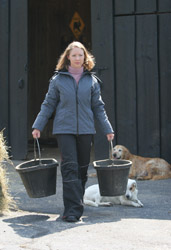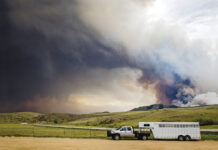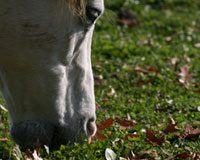 Few climates in the United States are so hospitable that horse owners never need to dress for cold weather. Even parts of warm states like Florida and Texas experience frost and snow from time to time. Because barn chores are tedious even without the added aggravation of stinging ears and numb fingers, a wide array of products exists to mitigate the cold.
Few climates in the United States are so hospitable that horse owners never need to dress for cold weather. Even parts of warm states like Florida and Texas experience frost and snow from time to time. Because barn chores are tedious even without the added aggravation of stinging ears and numb fingers, a wide array of products exists to mitigate the cold.
Since we need our hands for detailed tasks, they can’t be covered in bulky mittens all the time and can only find brief relief in a pocket before they are re-exposed to the elements. Warm gloves are crucial for winter barn chores. You’ll probably need several different types to address the various chores you do every day. For example, fleece-lined leather work gloves are great for warmth, protection, and durability, but not for adjusting a buckle or maintaining a soft feel of the bit. Gloves made of neoprene or microfiber with an insulated lining such as Thinsulate™ are great for chores that require more dexterity because they provide warmth without bulk.
Synthetic fleece is a popular material for everything from hats and scarves to socks, yet its prime drawback is its seemingly magnetic properties that attract hay, burrs, cobwebs, cat fur, horse hair and any other debris found around a barn. If the gloves’ exterior residue doesn’t bother you, fleece is soft, comfortable, and warm. It also wicks away sweat so you don’t build up moisture underneath it. Fleece also makes excellent horse coolers and winter quarter-blankets for the same reason.
If your gloves alone aren’t keeping feeling in your fingers, you can also use pocket hand-warmers. For less than a dollar each, these little heat packets will stay warm for hours.
If all else fails in sub-zero temperatures, consider hanging up a heat lamp that you can use to warm your hands.
Can you feel your toes?
Cold feet can cause you as much misery as frozen fingers. Insulated boots and thermal socks are essential when working in cold weather. Choose boots for warmth and function over style. To ensure proper fit, try on new boots with the thickness of socks that you will be wearing with them.
Socks should be warm and wick moisture away from your feet. Polypropolene and wool are excellent cold weather materials; Spandex ensures your socks won’t end in a wad at the bottom of your boots.
Always wear a hat
Hats keep your head from becoming an exhaust vent. Consider wearing a fleece balaclava, a one-piece head and neck cover that leaves only the wearer’s eyes exposed. Ear muffs are popular and some even snap onto riding helmets. Neck gaiters are warm and stay in place. Make sure scarves and outerwear are fitted so that they will not get caught in equipment.
Consider a not-too-toasty jacket
Many jackets are rated for comfort in a variety of temperatures. Find one that at first glance seems too light for your needs. Remember, the secret to staying comfortable in cold weather is to layer your clothes so that you are not stuck wearing a heavy jacket even after you’ve heated up. Silk long underwear is a traditional, lightweight base layer to which you can add other layers that can be removed as you begin to warm up.
Begin heat-seeking exercise
The best and cheapest way to stay warm in the barn is to start working immediately. Your body heats up quickly with exercise and you will probably be shedding layers within minutes.






gosh i’m dreading the time when i have to start wearing winter clothes to do chores. I love carhartt coats and insulated pants!!
I work in a pretty open barn that gets pretty darn cold during Wisconsin Winters. I can’t find a way to stay warm. I have Thinsulate gloves, 2 different pairs, and a pair of woven gloves that are pointless in midwinter. I use Little Hotties every day both feet and hands and the feet work great but regardless of whether I have 1 2 or 3 packets of hand warmers in my pockets, and no matter how many times I try to warm them up. Its getting pretty annoying. I NEED to get done with work sooner than I have been but I’m so cold all the time.
I left Arizona in mid-October on a 95 degree day and arrived in Washington state 3 days later to a balmy 27 degrees. Needless to say this has been a learning curve! Fortunately the people I am living with are veterans to this sort of weather, and have been most helpful. The base of my wardrobe has been my reliable old Carthart barn coat, and from there I have added various items; I now have enough winter clothes to stock a TSC! But my best find was a pair of insulated, knee-high riding boots. With deep treads, full-body fleece lining and even reflective strips (my friend jokes the better to find me in a snowstorm) my feet at least are keeping toasty and warm.